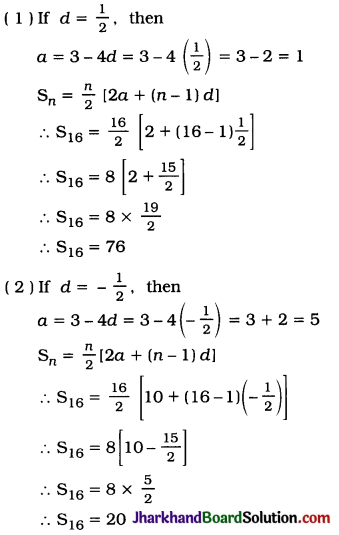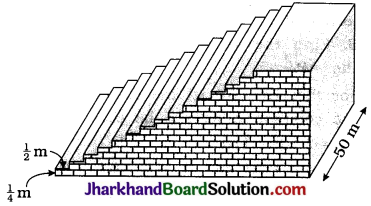Jharkhand Board JAC Class 10 Maths Solutions Chapter 5 Arithmetic Progressions Ex 5.4 Textbook Exercise Questions and Answers.
JAC Board Class 10 Maths Solutions Chapter 5 Arithmetic Progressions Exercise 5.4
Question 1.
Which term of the AP 121, 117, 113, …. is its first negative term?
[Hint: Find n for an < 0]
Solution :
For the given AP 121, 117, 113, … a = 121 and d= 117 – 121 = – 4.
Let nth term of the AP be its first negative term.
∴ an < 0
∴ a + (n – 1) d < 0
∴ 121 + (n – 1)(- 4) < 0
∴ 121 < 4 (n – 1) ∴ n > \(\frac{125}{4}\)
∴ n > 31\(\frac{1}{4}\)
Now, n being the number of a term is a positive integer and the smallest positive integer satisfying n > 31\(\frac{1}{4}\) is 32.
Hence, the 32nd term of the given AP is its first negative term.
![]()
Question 2.
The sum of the third and the seventh terms of an AP is 6 and their product is 8. Find the sum of first sixteen terms of the AP.
Solution :
For the given AP, let the first term be a and the common difference be d.
an = a + (n – 1) d
∴ a3 = a + 2d and a7 = a + 6d
According to given information,
a3 + a7 = 6
∴ (a + 2d) + (a + 6d) = 6
∴ 2a + 8d = 6
∴ a + 4d = 3
∴ a = 3 – 4d …………….(1)
Again, the product of a3 and a7 is 8.
∴ (a + 2d) (a + 6d) = 8
∴ (3 – 4d + 2d) (3 – 4d + 6d) = 8 [by (1)]
∴ (3 – 2d) (3 + 2d) = 8
∴ 9 – 4d² = 8
∴ 1 = 4d²
∴ d² = \(\frac{1}{4}\)
∴ d = \(\frac{1}{2}\) or d = – \(\frac{1}{2}\)

Thus, the required sum of first sixteen terms is 76 or 20.
Question 3.
A ladder has rungs 25 cm apart. (see the given figure). The rungs decrease uniformly in length from 45 cm at the bottom to 25 cm at the top. If the top and the bottom rungs are 2\(\frac{1}{2}\)m apart, what is the length of the wood required for the rungs?
Solution :

The distance between the top rung and the bottom rung = 2\(\frac{1}{2}\)m = 250 cm.
The distance between two successive rungs = 25 cm.
∴ Total number of rungs = \(\frac{250}{25}\) + 1 = 11
Including the top rung as well as the bottom rung
The length of the first (bottom) rung = 45 cm.
The length of the 11th rung at top = 25 cm.
The length of rung decreases uniformly.
Hence, the lengths (in cm) of rungs form an AP in which the first term = 45 and 11th term = 25.
an = a+ (n – 1)d
∴ a11 = a + 10 d
∴ 25 = 45 + 10 d
∴ – 20 = 10 d
∴ d = – 2
Thus, the length of rung uniformly decreases by 2 cm as we move from bottom to top.
Thus, the lengths (in cm) of rungs form a finite AP 45, 43, 41, ……….with 11 terms.
Then, sum of all the eleven terms will give the total length of the wood required for the rungs.
Sn = \(\frac{n}{2}\)(a + 1)
∴ S11 = \(\frac{11}{2}\)(45 + 25)
∴ S11 = \(\frac{11}{2}\) × 70
∴ S11 = 385
Thus, the total length of the wood required for the rungs is 385 cm.
![]()
Question 4.
The houses of a row are numbered consecutively from 1 to 49. Show that there is a value of x such that the sum of the numbers of the houses preceding the house numbered x is equal to the sum of the numbers of the houses following it. Find this value of x.
[Hint: Sx-1 = S49 – Sx]
Solution :
We know the sum of first n positive integers n(n+1) is given by Sn = \(\frac{n(n+1)}{2}\)
According to data, 1 + 2 + 3 + ……… + (x – 1) = (x + 1) + (x + 2) + ……….. + 49
∴ \(\frac{(x-1) \cdot x}{2}\) = (1 + 2 + 3 + … + 49) – (1 + 2 + 3 + … + x)
[Adding and subtracting (1 + 2 + 3 + … + x)}
∴ \(\frac{(x-1)(x)}{2}=\frac{49 \times 50}{2}-\frac{x(x+1)}{2}\)
∴ x(x – 1) + x(x + 1) = 49 × 50
∴ x² – x + x² + x = 49 × 50
∴ 2x² = 49 × 50
∴ x² = \(\frac{49 \times 50}{2}\)
∴ x² = 49 × 25
∴ x = 7 × 5
∴ x = 35
Thus, the value of x is 35.
Question 5.
A small terrace at a football ground comprises of 15 steps each of which is 50 m long and built of solid concrete. Each step has a rise of \(\frac{1}{4}\)m and a tread of \(\frac{1}{2}\)m (see the given figure). Calculate the total volume of concrete required to build the terrace.
[Hint: Volume of concrete required to build the first step = \(\frac{1}{4}\) × \(\frac{1}{2}\) × 50 m3]
Solution :

Volume of concrete required to build the first step = 50 × \(\frac{1}{2}\) × \(\frac{1}{4}\)m3 = \(\frac{25}{4}\)m3
Volume of concrete required to build the second step = 50 × \(\frac{1}{2}\) × (\(\frac{1}{4}\) + \(\frac{1}{4}\))m3 = \(\frac{25}{2}\)m3
Volume of concrete required to build the third step = 50 × \(\frac{1}{2}\) × (\(\frac{1}{4}\) + \(\frac{1}{4}\) + \(\frac{1}{4}\))m3 = = \(\frac{75}{4}\)m3 and so on up to 15 steps.
Thus, the volumes (in m3) of concrete required to build those 15 steps form the finite AP \(\frac{25}{4}\), \(\frac{25}{2}\), \(\frac{75}{4}\) …with 15 terms.
The sum of all the fifteen terms will give the quantity of total concrete required.
Here, a = \(\frac{25}{4}\), d = \(\frac{25}{2}-\frac{25}{4}=\frac{25}{4}\) and n = 15.
Sn = \(\frac{n}{2}\)[(2a + (n – 1) d]
∴ S15 = \(\frac{15}{2}\)[\(\frac{25}{2}\) +(15 – 1)\(\frac{25}{4}\)]
∴ S15 = \(\frac{15}{2}\) [latex]\frac{25}{2}+\frac{175}{2}[/latex]
∴ S15 = \(\frac{15}{2} \times \frac{200}{2}\)
∴ S15 = 15 × 50
∴ S15 = 750
Thus, 750 m3 of concrete is required to build the terrace.